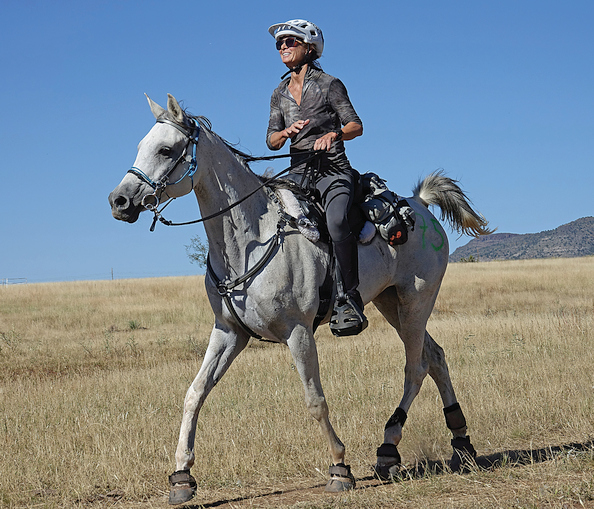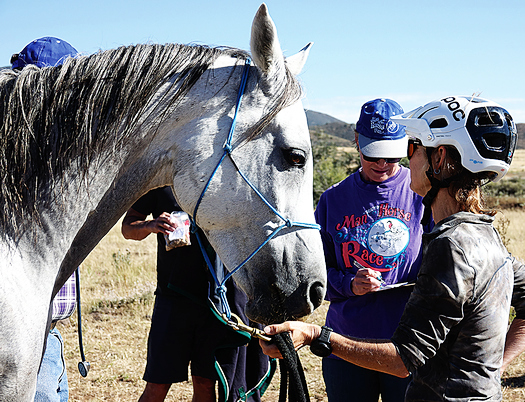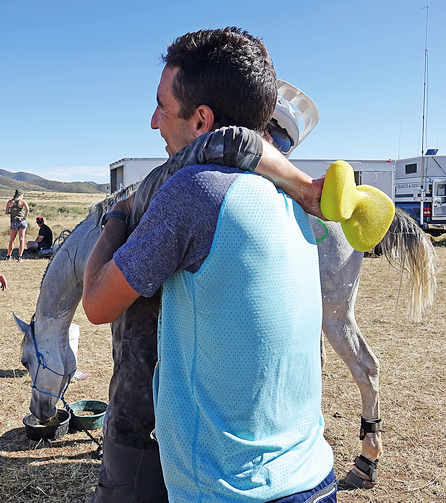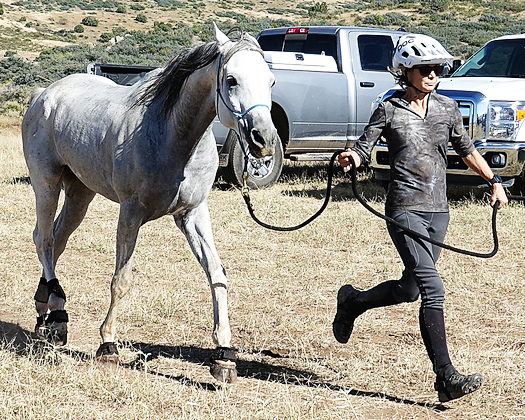By Heidi Dahms Foster
The annual Dewey Man Against Horse Race may be a bit obscure locally, but it’s legendary among long distance runners and endurance horse riders. The race, in which runners and riders have challenged themselves and each other for 35 of the past 37 years, took place on October 9.

While the weather cooperated beautifully this year, past years have served up heat, freezing cold, rain, sleet and hail, gale force winds, and sometimes snow, washed out trails and most anything else that can be imagined.
The 50-mile portion of this tough race begins just off Highway 89A and old Fain Road at the base of Mingus Mountain.
Horses and riders start just before sunrise, making their way through a rocky wash to head toward the mountain. The trail is rough, rocky, and in places, straight-up steep to an elevation of 7,600 feet. The views and terrain are epic.
This year, Susan Kramer, riding her Arabian horse Steel, bested first-place runner Nick Coury by an astonishingly slim margin of 2 minutes and 38 seconds, for a time of 6:49:54. Coury came in at 6:52:32.
Kramer also won one of the most coveted awards among endurance riders – the Best Condition award – given to the top ten horse that veterinarians judge to be in the best physical shape at the end of the race.

Coury and Kramer are friends, and both have had a couple of great years at the race. In 2019, Kramer won second place rider and Best Condition on Steel. Coury won the race overall.
Last year, Kramer kicked it up a notch and was the first rider in, again winning the Best Condition award, with Coury winning the race overall for a second time. This year Kramer took the top spot, with Coury coming in second.
The two laughed and hugged at the finish line, which is typical for this race that draws people from all over the country and cements long-term friendships.
Kramer, a long-distance runner herself, said she spent some years “catch riding,” or riding other people’s horses in long distance rides. She was casually looking for a horse of her own when a friend recommended Steel, whose registered name is “A Ali Aseel.”
He is a straight Egyptian Arabian, a breed known for their amazing endurance. She didn’t know all of that when she brought Steel home in 2016, but Kramer soon found she had an amazing partner for her long-distance adventures. He is currently ranked number three in the country for Best Condition awards in the American Endurance Ride Conference (AERC), the sanctioning body for endurance riders.
Two years ago, Kramer and Steel took on the Tevis Cup Ride, 100 miles in the Sierra High Country from Lake Tahoe, Nevada to Auburn, California in 24 hours. The two completed the ride, and this past July, competed again and came in fourth in a contest that only about 50 percent of entrants finish.
The month prior to the 2021 Tevis Cup, Kramer ran the trail in the Western States Endurance Run. She is only one of four women to complete the run and the ride in the same year.
Kramer said Steel, along with being uncommonly talented, is her “heart horse,” and a lot of fun. “He’s special,” she said. “He’s always been there for me – that constant in my life. I adore him.”
Around the house, Kramer said, Steel is the “man in charge,” the boss even though he’s the smallest of her three horses. She said he’s friendly and “smart as a whip.”
While the human runners in the Man Against Horse race are solely responsible for their own training, hydration, rest, pacing and safety, just the opposite is true for the horses.

Twenty-five and 50-mile horses must first qualify for the race, then pass a number of veterinarian checks, where their heart rate, hydration, soundness and general condition are recorded. If a veterinarian deems a horse unfit to continue at any point along the trail, that horse is pulled from the race. At the finish line, the horse must stand for and pass a final check. Then, the 75 required minutes of vet and rest checks are deducted from the total time.
This year, Nick Coury crossed the finish line well ahead of other runners and horses. Kramer’s boyfriend texted her when she was seven miles from the finish line, telling her that she and Steel had 30 minutes if they wanted to win. “I thought, seven miles in 30 minutes? No way!”
Kramer knows she has an amazing equine partner, and she doesn’t push him.
“He pushes himself,” she said. “He knows if he’s in second place. He knows when he crosses the finish line that he’s won – and he loves to win.” He was eager to forge to the finish line, but Kramer still had to pay attention to the balancing act that is the horse’s condition and comfort versus the time to win.

The two loped across the finish line – Steel looking like he could easily go another 50 and Kramer with a huge grin. And the condition? That Best Condition award told Kramer that she balanced speed and care of her horse just right.
A great horse is just the start of a successful endurance team. The rest is just plain work.
Care includes the best food and supplements and constant conditioning, and the secret ingredient – the relationship of horse and rider. At this level, Kramer has to enjoy her horse – she spends a lot of time with Steel. She rides out for 17-25 miles three days a week, and throws in a shorter “leisure” ride on a fourth day She’s careful that Steel doesn’t get burned out or bored, and he can surely sense if the same happens to her.
The Man Against Horse Race can have its challenges, which Kramer and Steel have had to overcome each time.
The first time she ran the race, someone moved marker ribbons and she went off course, riding an extra seven miles. Steel was still the first horse across the finish line. Now, GPS solves the issue of moving markers.

This year, Kramer said Steel’s protective hoof boots (an alternative to shoes) came off some 20 times, forcing her to stop and put them back on.
“It was kind of a zoo!” she said. “At one point, all four came off! By then, I had no thought of winning.”
What’s ahead for this competitive duo for the rest of the AERC year? Just three more rides of 50-75 miles. “I might jump to a 100, or drop to a 50,” Kramer said. “Then December starts a new season,” Kramer said.
In the 25-mile race this year, John Simpson and his mount TWC Rock My World won the horse contest in 3:52, and also took home the Best Condition award for their distance. Neil Truckenbrod was the first 25-mile runner across the finish line in 4 hours. Amy Hobson was the first woman across the line in 4:20.
In the 12-mile (horses do not compete in this one, it’s considered a trail ride), Thomas Koska in 1:26 and Schanda Demoust at 1:59 were the winners.
Race director Ron Barrett thanked all of the volunteers who made this year’s race a success. The Yavapai County Jeep Posse put 50 people on the trail from base camp to the top of the mountain, manning checkpoints, relaying information, and making sure everyone was safely off the trail at the end of the day.
“The Jeep Posse is so important. They put out 50 people on the mountain. All of the competitors were so impressed with them,” he said.
Other volunteers worked hard on all of the other aspects of this well-run event.
For final results and photos of this year’s race as they become available, visit ManAgainstHorse.net.

